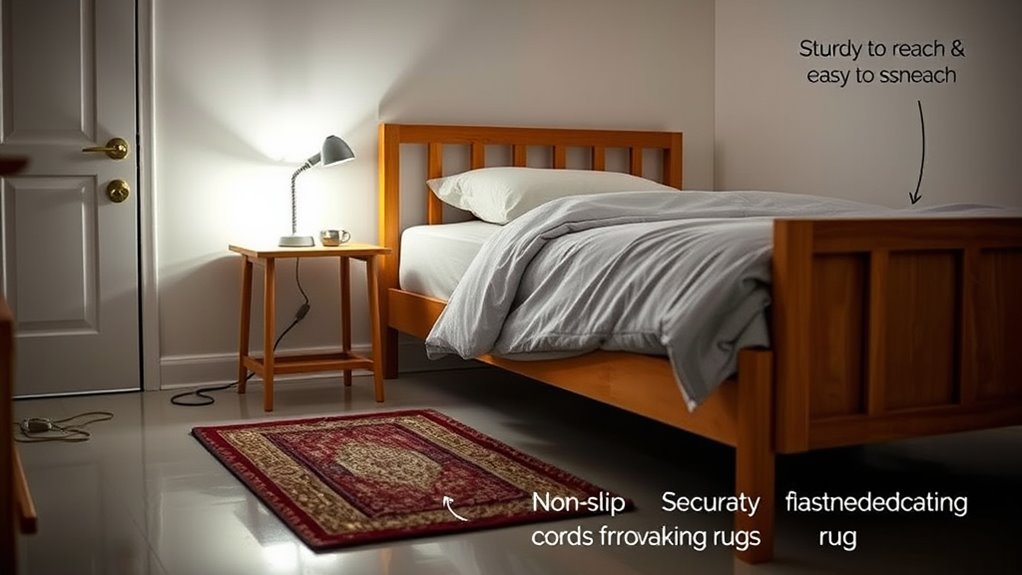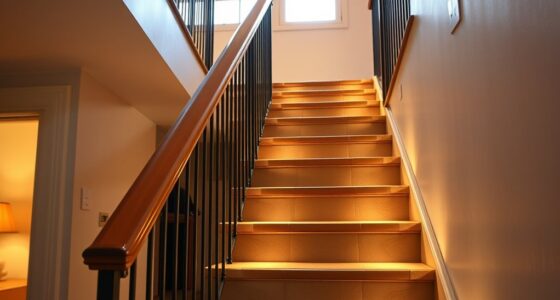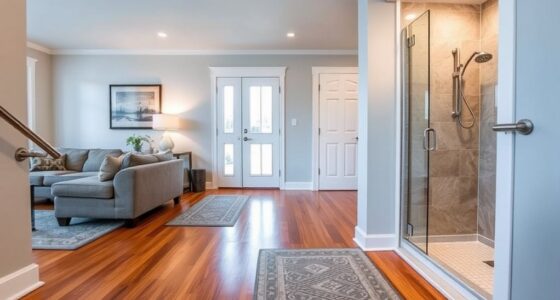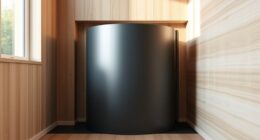To prevent nighttime falls in your bedroom, guarantee there’s enough lighting with easy-to-reach switches, motion-activated lights, and nightlights along your path. Clear clutter from walkways, use non-slip rugs, and keep essential items within arm’s reach. Adjust furniture for stability and add grab bars if needed. Regularly check that lighting stays functional and pathways remain unobstructed. For even safer nights, discover more ways to create a secure, accessible environment in your space.
Key Takeaways
- Ensure proper lighting with night lights and motion-activated fixtures to prevent dark areas and accidental falls.
- Keep pathways clear of clutter and cords, and secure rugs to reduce tripping hazards.
- Adjust bed height and add grab bars for easier transfers and stability during night movements.
- Place essential items within easy reach to avoid unnecessary movement and potential falls.
- Regularly inspect furniture, lighting, and flooring for stability and safety to maintain a hazard-free environment.

Have you ever considered how safe your bedroom truly is? Many accidents happen during the night, especially for seniors, and a substantial number of these incidents involve falls. To reduce this risk, focusing on simple yet effective safety measures can make a big difference. One of the first steps is improving your lighting. Bright, well-placed lighting helps you see clearly when moving around in the dark, preventing missteps and trips. Consider installing overhead lights with easy-to-reach switches, adding night lights along the path from your bed to the bathroom, and ensuring that the lighting is sufficient without being harsh. Motion-activated lights are also a smart choice because they turn on automatically when you get up, minimizing the need to fumble for switches in the dark.
Along with lighting improvements, paying attention to furniture arrangements can considerably enhance your safety. Keep pathways clear of clutter to prevent tripping hazards. Make sure your bed is positioned in a way that allows easy access, ideally close to a wall or corner to offer support when getting in and out of bed. Avoid placing furniture with sharp edges near your usual walking path; if unavoidable, add corner protectors or padding. Use furniture that is stable and not easily tipped over, like sturdy chairs or beds with strong frames. The height of your bed matters too—if it’s too high or too low, it can make standing up or sitting down more difficult, increasing fall risk. Consider adding a sturdy handrail or grab bar near the bed for extra support during transfers.
Additionally, think about the placement of essential items. Keep your glasses, medications, or a glass of water within easy reach so you don’t have to stretch or search in the dark. Non-slip rugs or mats on the floor can prevent slipping, but make sure they’re securely anchored to the floor to avoid tripping over edges. Remove any cords or wires that cross walkways, and ensure the floor surface is even and free of loose carpeting or tiles. Regularly inspect your furniture and lighting fixtures to ensure they remain secure and functional. Incorporating home theater projectors with adjustable brightness can also help create a safe and comfortable environment by providing sufficient illumination without glare. Being aware of lighting safety and choosing the right fixtures can further reduce hazards and promote a secure space for nighttime mobility. Regularly checking your furniture stability and ensuring pathways are unobstructed helps prevent accidents. Additionally, investing in smart home technology can enable remote control over lighting and other safety devices, adding an extra layer of security. Using motion sensors can further enhance safety by alerting you to movement in the room during nighttime hours. These small adjustments not only make your bedroom more accessible but considerably lower your chances of nighttime falls.
Frequently Asked Questions
How Can I Make a Senior’s Bedroom More Visually Accessible at Night?
To make a senior’s bedroom more visually accessible at night, you should focus on improving visibility with color contrast and visual cues. Use bright, contrasting colors on furniture edges and pathways to guide their way. Add nightlights that cast gentle, consistent light without causing glare. Clear clutter and mark steps or changes in floor height with visual cues. These steps help seniors navigate safely and confidently, reducing fall risks during nighttime.
What Are the Best Types of Lighting for Nighttime Safety?
Nighttime lighting isn’t just about brightness; it’s about smart safety. You should use smart bulbs that adjust brightness automatically, creating a gentle, non-intrusive glow. Pair them with motion sensors that turn lights on instantly when needed, reducing fall risks. This combo provides immediate illumination, making it easier for seniors to navigate their room. It’s a smart way to promote safety without sacrificing comfort or independence during nighttime hours.
How Do I Address Mobility Issues in Bedroom Design?
To address mobility issues in bedroom design, you should incorporate assistive devices like grab bars and easy-to-reach storage. Use ergonomic furniture with supportive features and adjustable heights to make moving and transferring safer. Keep pathways clear of clutter, and add non-slip rugs for stability. These modifications help you move comfortably and safely, reducing the risk of falls and enhancing independence during nighttime routines.
Are There Specific Flooring Options That Reduce Fall Risk?
They say a smooth sea never made a skilled sailor, and the same applies to flooring choices. Opt for non-slip flooring options like textured vinyl or cushioned surfaces, which provide better grip and reduce fall risk. These surfaces absorb impact and prevent slips, creating a safer environment. Prioritize these materials to help you move confidently and stay secure, especially during nighttime trips around the bedroom.
How Can I Prevent Falls Caused by Clutter or Obstacles?
To prevent falls caused by clutter or obstacles, you should focus on clutter management and obstacle removal. Keep pathways clear by regularly tidying up and removing unnecessary items, especially near your bed. Use organizers or storage bins to contain clutter, and make sure rugs are secure with non-slip mats. Good lighting helps you see obstacles clearly at night, reducing the risk of tripping and falling.
Conclusion
By making small changes, you create a sanctuary where the night feels safe. Imagine slipping into your bed, knowing the floor is clear, the lighting gentle, and your path well-lit. With each careful step, you build a haven of comfort and security, reducing the risk of falls. When you prioritize your bedroom safety, you turn your space into a peaceful retreat—where restful sleep replaces worry, and every night ends with a sense of calm and confidence.









